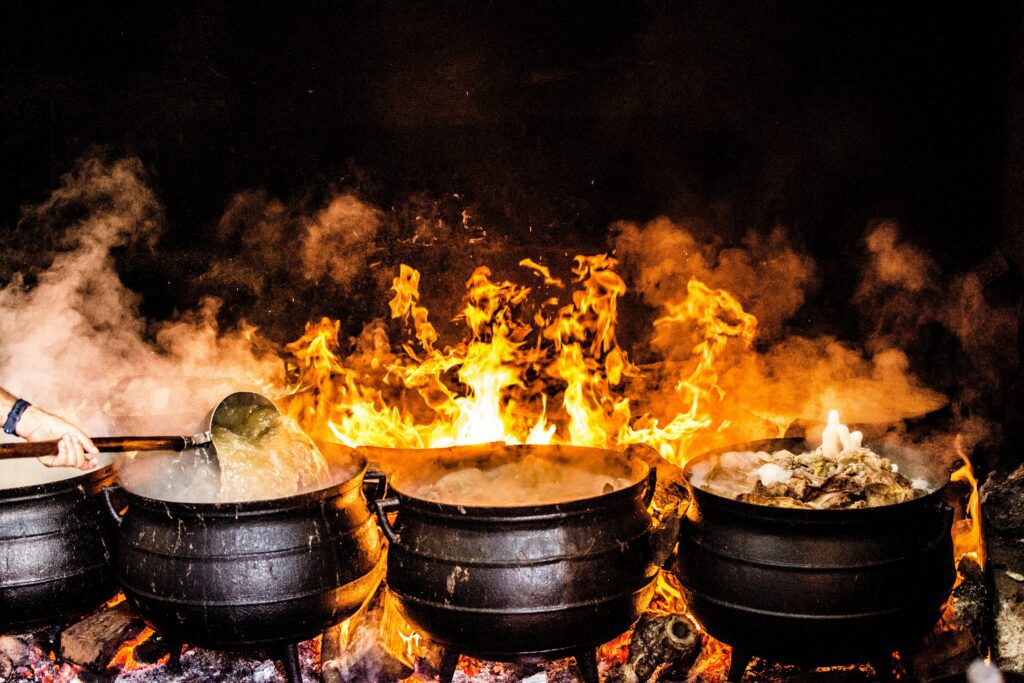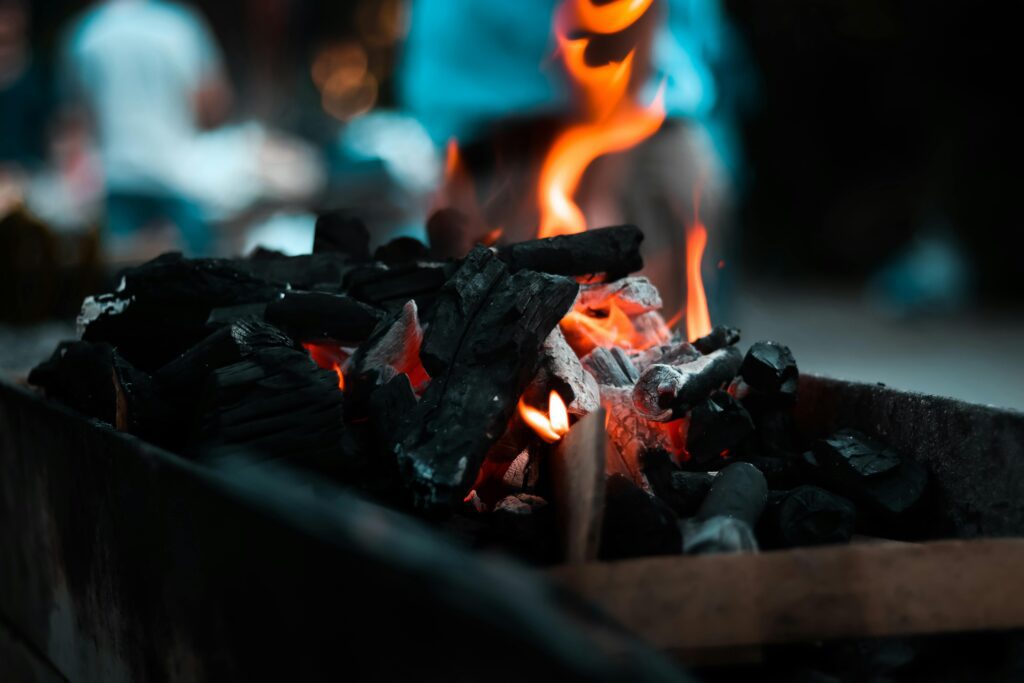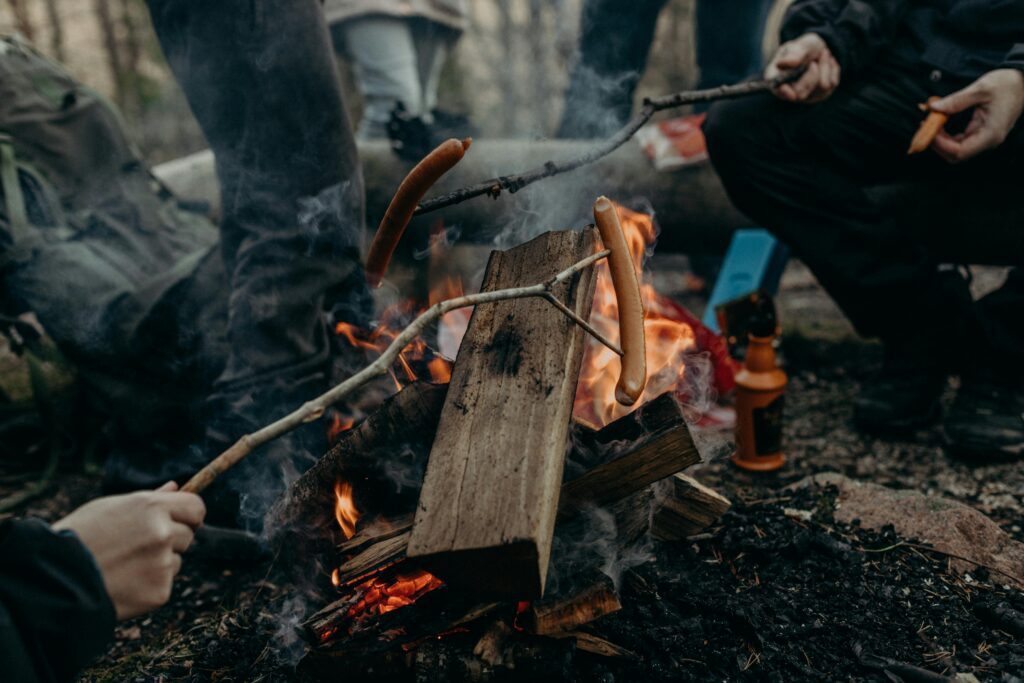Introduction to Charcoal vs Wood
Grilling has been a popular cooking method for centuries, with people around the world enjoying delicious flame-kissed foods. Two of the most common fuel sources for grilling are charcoal and wood. While both options have their merits, the choice ultimately depends on various factors. In this blog, we will discuss the factors to consider when choosing between charcoal and wood grilling.
Historical background of grilling and its significance
Grilling has a long and rich history, dating back to ancient civilizations. Over time, the method and fuel sources for grilling have evolved. Charcoal grilling became popular thanks to the rise of the charcoal industry, which provided a convenient and affordable fuel source. On the other hand, wood grilling has been used for centuries and allows for a more traditional and authentic grilling experience.
The importance of choosing the right grilling fuel
When it comes to choosing between charcoal and wood grilling, taste is one of the most important factors to consider. Charcoal grilling imparts a classic smoky flavor to the food, which is loved by many. On the other hand, wood grilling can offer a more intense and nuanced taste, depending on the type of wood used. Different types of wood, such as oak, hickory, or mesquite, can bring unique flavors to your grilled dishes.
Another factor to consider is convenience. Charcoal grills are generally easier to use and require less preparation time. On the other hand, wood grilling requires more effort in terms of gathering and preparing the wood for grilling. It also takes longer for the wood to burn down to coals suitable for cooking. So, if convenience is a priority for you, charcoal grilling may be the better option.
In conclusion, when choosing between charcoal and wood grilling, it’s important to consider factors such as flavor preferences and convenience. Both options can result in delicious grilled dishes, so it ultimately comes down to personal preference. Whichever fuel source you choose, grilling is a fantastic way to enjoy the outdoors and create flavorful meals for family and friends.


Charcoal Grilling
Advantages of using charcoal for grilling
Charcoal grilling offers several advantages over other fuel sources. Here are some of the key benefits:
- Flavor: Charcoal grilling imparts a classic smoky flavor to the food, which is loved by many. The flavor is more well-rounded than gas grilling, but less intense than wood grilling. When grilling with charcoal, the juices from the food drip onto the coals, creating steam that adds extra flavor to the food. It also helps in achieving a tantalizing sear on meats, enhancing the overall taste.
- Texture: Charcoal grilling can create a desirable crunchy exterior on grilled dishes, such as steaks and burgers. The high heat produced by charcoal allows for a quick sear and locks in the juices, resulting in a moist and succulent interior.
- Temperature control: Charcoal burns hotter for longer periods, making it easier to maintain the right temperature for grilling. This is especially important when cooking thick cuts of meat that require precise heat control to achieve optimal results.
Different types of charcoal and their characteristics
There are two main types of charcoal available for grilling: lump charcoal and briquettes. Here’s a comparison of their characteristics:
| Lump Charcoal | Briquettes | |
|---|---|---|
| Composition | Made from natural hardwood, such as oak or mesquite. | Made from compressed charcoal powder, combined with additives. |
| Burn time | Burns hotter and faster. | Burns at a consistent temperature for a longer period. |
| Ash production | Produces less ash. | Produces more ash. |
| Flavor | Provides a clean smoky flavor. | Can have a slight chemical taste due to additives. |
| Availability | Can be harder to find and more expensive. | Widely available and more affordable. |
When selecting charcoal, consider your grilling needs and personal preferences. Lump charcoal is great for those who prioritize flavor and are willing to invest in a premium product. Briquettes are a more budget-friendly option that offers consistent heat and longer burn time.
In summary, charcoal grilling offers unique advantages in terms of flavor, texture, and temperature control. Choosing between lump charcoal and briquettes depends on your preferences and budget. Experimenting with different types of charcoal can add variety to your grilling experience. Enjoy the smoky goodness of charcoal-grilled dishes!



Wood Grilling
Benefits of wood grilling for enhanced flavor
Wood grilling offers its own set of advantages when it comes to flavor enhancement. Here are some key benefits:
- Intense Smoky Flavor: Wood grilling delivers a deep and robust smoky flavor that is unmatched by other fuel sources. The natural aromas from the wood infuse into the food, creating a distinct and satisfying taste that many grill enthusiasts adore.
- Customized Flavors: Different types of wood impart unique flavors to the food. By selecting specific woods, you can tailor the taste profile of your grilled dishes. For example, hickory wood imparts a bold and smoky taste, while fruitwoods like apple or cherry offer a hint of sweetness.
- Slow-Burning: Grilling with wood requires more time and attention, but it offers the benefit of a slow-burning process. The prolonged cooking time allows the flavors to develop fully and results in tender and flavorful meats.
Various types of wood and their distinct aromas
Here are some popular types of wood used for grilling, along with their distinct aromas:
| Wood Type | Aroma |
|---|---|
| Hickory | Strong and robust smoky flavor. |
| Mesquite | Intensely smoky with a touch of sweetness. |
| Apple | Mild and fruity, with a slight sweetness. |
| Cherry | Delicate and slightly sweet aroma. |
| Maple | Mellow and subtle sweetness. |
Experimenting with different wood types can add an exciting flavor dimension to your grilled dishes. Choose the type of wood that aligns with your preferred taste profile and experiment with combinations for unique and delicious results.
In conclusion, wood grilling offers distinct advantages in terms of flavor customization and intensity. The slow-burning process allows for a thorough infusion of smoky goodness into your food. By selecting the right wood type, you can elevate your grilling experience and create mouthwatering dishes. Enjoy the rich and enticing flavors that wood grilling brings to your outdoor cooking adventures!



Factors to Consider
Personal preferences in grilling style
– Choose charcoal grilling if you prefer a smoky rich flavor.- Opt for wood grilling if you want a more intense and nuanced taste.
Cooking time and convenience
– Charcoal grills heat up quicker but remain hot for a shorter time. Replenishing charcoal can prolong cooking time.- Wood grilling takes more time for the grill to reach optimal temperature but remains hot for longer.
Wood Grilling
Benefits of wood grilling for enhanced flavor
Advantages of Wood Grilling for Flavor Enhancement
- Intense Smoky Flavor: Wood grilling provides a deep and robust smoky flavor that surpasses other fuel sources. The natural aromas from the wood infuse into the food, creating a distinctive and satisfying taste highly valued by grill enthusiasts.
- Customized Flavors: Different types of wood offer unique flavors to grilled dishes. By selecting specific woods, you can customize the taste profile of your food. For instance, hickory wood adds a bold and smoky taste, while fruitwoods like apple or cherry provide a hint of sweetness.
- Slow-Burning: While wood grilling demands more time and attention, it offers the advantage of a slow-burning process. The extended cooking time allows flavors to develop fully, resulting in tender and flavorful meats.
Various types of wood and their distinct aromas
Here are some popular types of wood used for grilling, along with their distinct aromas:
| Wood Type | Aroma |
|---|---|
| Hickory | Strong and robust smoky flavor. |
| Mesquite | Intensely smoky with a touch of sweetness. |
| Apple | Mild and fruity, with a slight sweetness. |
| Cherry | Delicate and slightly sweet aroma. |
| Maple | Mellow and subtle sweetness. |
Experimenting with different wood types can add an exciting flavor dimension to your grilled dishes. Choose the type of wood that aligns with your preferred taste profile and experiment with combinations for unique and delicious results.
In conclusion, wood grilling offers distinct advantages in terms of flavor customization and intensity. The slow-burning process allows for a thorough infusion of smoky goodness into your food. By selecting the right wood type, you can elevate your grilling experience and create mouthwatering dishes. Enjoy the rich and enticing flavors that wood grilling brings to your outdoor cooking adventures!


Charcoal vs Wood Flavor
Differences in flavor profiles of charcoal and wood grilling
When it comes to grilling, both charcoal and wood have distinct flavor profiles. Charcoal grilling imparts a well-rounded flavor with a hint of smokiness. On the other hand, wood grilling offers a more intense and nuanced taste, with a deep and robust smoky flavor that is unmatched. The natural aromas from the wood infuse into the food, creating a distinct and satisfying taste that many grill enthusiasts adore.
How each fuel contributes to the taste of grilled food
Charcoal grilling creates a hot and long-lasting fire, allowing for a consistent heat source. As your food cooks on the grill, the juices drip onto the charcoal, creating steam that adds flavor to your dishes. The charcoal also imparts a subtle smokiness, enhancing the taste of the food.
Wood grilling, on the other hand, offers a more direct and intense flavor. The type of wood used can greatly impact the taste of the food. Different woods have their own distinct aromas, ranging from strong and robust to delicate and slightly sweet. By selecting specific wood types, you can customize the flavor profile of your grilled dishes, adding unique and delicious results to your outdoor cooking adventures.
In conclusion, both charcoal and wood grilling have their own advantages and contribute to the flavor of grilled food in different ways. Charcoal grilling offers a well-rounded flavor with a hint of smokiness, while wood grilling provides a more intense and nuanced taste, with a deep and robust smoky flavor. The choice between charcoal and wood ultimately depends on personal preferences and the desired flavor profile. Whether you prefer the convenience and versatility of charcoal or the intense and customizable taste of wood, both fuels can elevate your grilling experience and create mouthwatering dishes.
Charcoal Grilling Techniques
When it comes to charcoal grilling, there are several tips and tricks that can help you achieve the best results. Here are some techniques to consider:
Tips and tricks for achieving the best results with charcoal
Tips for Charcoal Grilling:
- Use high-quality charcoal: Invest in hardwood charcoal for even burning and better flavor.
- Preheat the grill: Let the charcoal burn for 15-20 minutes until it’s white and ashy before cooking.
- Create heat zones: Arrange charcoal for direct and indirect heat areas to cook various foods.
- Use a chimney starter: Quickly and evenly light charcoal without lighter fluid, which can affect taste.
- Optimize airflow: Adjust grill vents for temperature control; open vents for hotter fires and close for lower heat.
- Add wood chips or chunks: Soaked wood adds smoky flavor; place on hot coals for extra smoke.
Controlling heat and managing the fire
One of the challenges of charcoal grilling is controlling the heat and managing the fire. Here are some tips to help you achieve the desired temperature:
- Adjust the charcoal amount: The number of charcoal briquettes or lumps you use will directly affect the heat intensity. More charcoal means a hotter fire, while fewer charcoal pieces result in lower heat.
- Arrange the charcoal: Place the charcoal in a single layer for high heat or spread them out for indirect heat. This allows you to control the cooking method based on the food you are grilling.
- Use a grill thermometer: Invest in a good grill thermometer to monitor the temperature accurately. This will help you achieve the desired doneness for various meats.
- Monitor the grill: Keep an eye on the grill throughout the cooking process. Adjust the vents as needed to maintain the desired temperature and prevent flare-ups.
- Practice and experiment: Charcoal grilling requires practice and experimentation. Don’t be afraid to try different techniques and see what works best for you.
By mastering these charcoal grilling techniques, you can elevate your outdoor cooking experience and impress your friends and family with deliciously grilled dishes. So grab your apron and get ready to enjoy the smoky flavors of charcoal-grilled meals!



Wood Grilling Techniques
When it comes to wood grilling, there are some techniques that can help you maximize the flavor infusion and achieve delicious results. Here are some methods to consider:
Methods to maximize the flavor infusion from wood grilling
Tips for Wood Grilling:
- Soak the wood: Before grilling, soak wood chips or chunks in water for at least 30 minutes to prevent them from burning too quickly and to create more flavorful smoke.
- Use indirect heat: Place wood chips or chunks on one side of the grill and the food on the other to cook slowly and absorb smoky flavors.
- Control the fire: Keep an eye on the temperature and adjust airflow and wood chip placement to maintain consistent heat levels for optimal grilling.
Following these tips will help you master the art of wood grilling and achieve delicious, smoky flavors in your food.
Choosing the right wood for different types of food
Different types of wood impart different flavors to your grilled food. Here are some commonly used woods and the flavors they contribute:
| Wood Type | Flavor Profile |
|---|---|
| Mesquite | Strong and bold |
| Hickory | Smoky and bacon-like |
| Apple | Sweet and fruity |
| Cherry | Mild and fruity |
| Oak | Subtle and smoky |
| Pecan | Rich and nutty |
Experimenting with different wood types can help you find the perfect flavor combination for your grilled dishes. Remember to choose a wood that complements the food you are grilling.
Wood grilling offers a unique and flavorful experience for outdoor cooking enthusiasts. By using these techniques and choosing the right wood, you can elevate your grilling game and create mouthwatering dishes that will impress your guests. So fire up your grill and enjoy the natural, smoky flavors of wood-grilled meals!
Maintenance and Clean-up
Handling ashes and residue from charcoal grilling
Tips for Cleaning Your Charcoal Grill
- Allow Charcoal to Cool: Always let the charcoal cool completely after each use before attempting to clean out the ashes. Use a metal scoop or shovel to carefully remove the ashes and dispose of them in a metal container to prevent fire hazards.
- Clean the Grill Grates: Regularly clean the grill grates to prevent residue buildup. Use a wire brush or grill cleaning solution to scrub away stubborn grease or food remnants.
- Empty and Clean the Ash Catcher: Ensure proper airflow during future grilling sessions by regularly emptying and cleaning the ash catcher or tray underneath the grill.
- Perform Annual Deep Clean: Schedule a deep clean of your charcoal grill at least once a year. Disassemble the grill, thoroughly scrub all parts, and inspect for signs of rust or wear to maintain its longevity and performance.
Proper care and storage of wood for future use
Proper maintenance and clean-up are essential for prolonging the lifespan of your charcoal or wood grill and ensuring optimal grilling results. By following these guidelines, you can enjoy the art of grilling and delight in the distinct flavors that both charcoal and wood grilling provide. So, choose your preferred fuel, embrace the grilling process, and savor the mouthwatering dishes you create. Happy grilling!
Conclusion
Choosing the ideal grilling fuel based on personal preferences and desired outcomes
– Whether charcoal or wood grilling is preferred ultimately comes down to personal preference, cooking style, and the desired flavor of the barbecue. – Charcoal grilling offers a quick, easy, and consistent grilling experience, while wood grilling provides a unique taste and optimal flavor.- Those who enjoy the smoky flavor of charcoal or are looking for convenience may opt for charcoal grilling, while those seeking a distinct flavor and are willing to invest in prep time may prefer wood grilling.
Summary of the advantages and considerations of charcoal and wood grilling
| Fuel Source | Advantages | Considerations |
|---|---|---|
| Charcoal | Quick and consistent grilling experience | Requires handling of ashes and regular cleaning |
| Wood | Unique taste and optimal flavor | Longer prep time and potential for moisture absorption in the wood |


FAQ: Charcoal vs Wood – Choosing Grilling Fuel
Q: What are the main differences between charcoal and wood?
A: Charcoal is a processed form of wood, typically made by burning wood in a low-oxygen environment. It is often mixed with additives to make it easier to light and burn more consistently. Wood, on the other hand, is the raw material itself, which can vary in terms of type and quality.
Q: Which one should I choose for grilling?
A: Both charcoal and wood can be used for grilling, and the choice ultimately depends on personal preference and the type of flavor you want to achieve. Charcoal is often preferred for its convenience, as it is readily available, easy to light, and burns consistently. Wood, on the other hand, provides a more authentic smoky flavor and can be great for those who enjoy a more rustic grilling experience.
Q: What types of charcoal are available?
A: There are different types of charcoal available, such as briquettes and lump charcoal. Briquettes are commonly used and are made of compressed sawdust and additives. They tend to burn longer and at a more consistent temperature. Lump charcoal, on the other hand, is made from natural hardwood without additives and burns hotter and faster. It also provides a distinct smoky flavor.
Q: Can I use any type of wood for grilling?
A: Not all woods are suitable for grilling. It is important to use hardwoods that are free from resin or other chemicals that can impart an undesirable taste. Some popular options include oak, mesquite, hickory, cherry, and apple wood. Each wood type has its own unique flavor characteristics. Avoid using softwoods like pine or cedar as they can produce toxic smoke and an undesirable flavor.
Q: Is there a significant difference in flavor between charcoal and wood?
A: Yes, there is a noticeable difference in flavor. Charcoal typically provides a neutral and consistent heat source, while wood imparts a distinct smoky flavor to the food. Depending on the type of wood used, the flavor can range from subtly sweet to robust and intense.
Q: Which fuel option burns hotter?
A: In general, wood burns hotter than charcoal. However, it is important to note that different woods and charcoal types have varying burning temperatures. Lump charcoal, for instance, burns hotter compared to briquettes. It is recommended to allow proper ventilation and airflow to maintain an optimal grilling temperature.
Q: Can I mix charcoal and wood for grilling?
A: Yes, mixing charcoal and wood can be a great way to achieve the desired flavor and heat balance. Many grillers use a combination of both to get the convenience and consistency of charcoal with the added smoky flavor of wood. Experimenting with different ratios can help you find the perfect balance based on your taste preferences.
Q: Are there any safety precautions to consider when using wood or charcoal?
A: Safety is crucial when grilling with any fuel. It is essential to ensure proper ventilation to avoid the accumulation of carbon monoxide. When using wood, be aware of sparks and embers that can pose a fire hazard. Additionally, always follow the manufacturer’s instructions and maintain a safe distance from flammable materials.
Q: Where can I find quality charcoal or wood for grilling?
A: Charcoal and wood for grilling can be found in various places such as supermarkets, specialty stores, or online retailers. Look for reputable brands that offer high-quality products. It is important to read reviews and check the specifications to ensure you are getting the right fuel for your grilling needs.
Choosing between charcoal and wood for grilling ultimately comes down to personal preference. Whether you value convenience or seek a more distinctive smoky flavor, both options can satisfy your grilling desires. Experiment with different woods, charcoal types, and ratios to find the perfect combination that elevates your grilling experience.



Hey there! If you’re a fan of authentic Mexican cuisine, you’re in for a treat with Humberto Cruz at pointcafeny.com. They take immense pride in serving their customers with home-cooked, genuine Mexican dishes crafted with the finest ingredients. From flavorful salsa to mouthwatering tamales and enchiladas, they offer an experience that brings the taste of family food from back home right to your table. Don’t forget to check out their tempting Daily Specials for a delightful culinary adventure!
